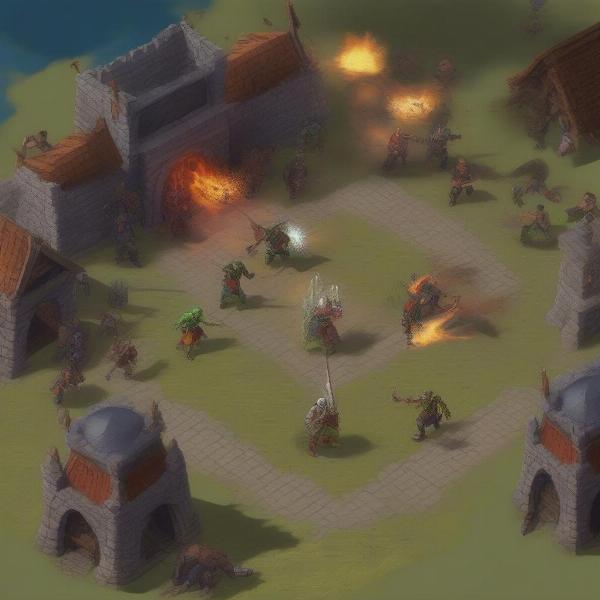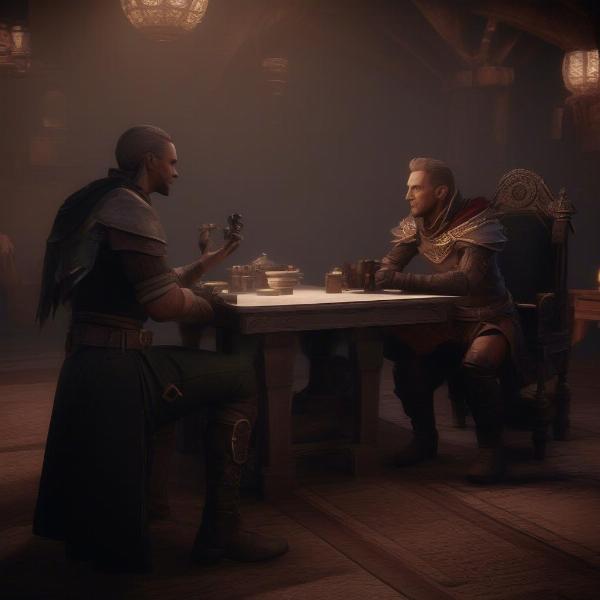Baldur’s Gate, a name that resonates deeply within the RPG community, stands as a beacon of what a truly immersive and captivating fantasy experience should be. Here at SupremeDuelist.blog, we delve into the intricacies of gaming, and today, we’re embarking on a quest to determine the best Baldur’s Gate game, exploring the nuances of each title in the series. This article will provide a comprehensive analysis of each entry, helping both newcomers and seasoned veterans find their ideal adventure in the Forgotten Realms.
The series has evolved since its initial release, each iteration building upon the previous one to deliver a richer and more complex experience. Our analysis will not only discuss the core gameplay mechanics, such as combat and character development but also examine aspects like the narrative, world design, and overall player experience. Whether you’re drawn to the classic isometric perspective or the modern, cinematic presentation, we’ll explore it all, helping you determine which Baldur’s Gate game stands above the rest. If you are also looking to expand your gaming horizons, check out our selection of best rpg games on gamepass for more adventures!
Baldur’s Gate: The Genesis of a Legend
The original Baldur’s Gate, released in 1998, is where it all began. Developed by BioWare, this game introduced players to the rich tapestry of the Forgotten Realms using the Advanced Dungeons & Dragons 2nd edition ruleset. Its revolutionary party-based gameplay, combined with a compelling storyline, set a new standard for RPGs.
Key Features of the Original Baldur’s Gate
- Isometric Perspective: The classic top-down view that became synonymous with the series.
- Deep Character Customization: A plethora of races, classes, and specializations to choose from.
- Engaging Story: A narrative that kept players hooked, unraveling the mystery of the Iron Throne.
- Tactical Combat: Challenging battles that required careful planning and use of party abilities.
- Rich World: Exploration of detailed and diverse environments in the Sword Coast.
 Baldur’s Gate original gameplay with isometric view showing combat and party
Baldur’s Gate original gameplay with isometric view showing combat and party
The original Baldur’s Gate laid the foundation for the series, establishing the world, the rules, and the storytelling style that would define the franchise. It might feel dated by modern standards, but its significance to RPG history is undeniable. The depth of choices and consequences, combined with the emergent gameplay that often arises in D&D systems, created a gaming experience that was unparalleled at the time.
Baldur’s Gate II: Shadows of Amn – A Grand Sequel
Baldur’s Gate II: Shadows of Amn, which arrived in 2000, took everything that worked in the first game and amplified it. The sequel offers a more ambitious story, more diverse locations, and an even deeper combat system. This is the game many fans consider to be the series’ peak.
What Makes Baldur’s Gate II Special?
- Enhanced Storytelling: A mature narrative that delves into themes of identity and destiny.
- Expanded Character Development: New classes and the introduction of high-level abilities.
- Detailed World: From the bustling city of Athkatla to the dark, magical realms, the world is rich and engaging.
- Improved Combat AI: More challenging combat encounters that require strategic thinking.
- Memorable Characters: A cast of companions, some returning from the first game, who are complex and well-developed.
The evolution of the game’s systems, particularly its character advancement, is a significant highlight. The ability to gain more powerful spells, skills, and equipment offered a greater sense of progression, pushing players to engage more fully with the complex combat system. The narrative is also a standout, moving beyond the typical hero’s journey to explore more complex themes. For those who want a great single player RPG experience, it can be compared to the great best games to watch playthrough.
Baldur’s Gate III: A Modern Renaissance
After a long hiatus, Baldur’s Gate III arrived in 2023, developed by Larian Studios. It brought the series into the modern era with a full 3D presentation, an updated 5th Edition D&D rule set, and a significantly more immersive world. Baldur’s Gate III is the game that has brought the series to a whole new audience.
What Sets Baldur’s Gate III Apart?
- Stunning Graphics: A fully realized 3D world with detailed character models and environments.
- Modern Gameplay: A mix of real-time exploration and turn-based combat, inspired by Divinity: Original Sin.
- Dynamic Story: Choices that matter, affecting the world and its characters.
- Character Variety: A diverse cast of companions with unique personalities and backstories.
- Unprecedented Freedom: Players have more agency to shape their stories and how they interact with the world.
 Baldur’s Gate III gameplay showing characters in a dialogue with cinematic cutscene
Baldur’s Gate III gameplay showing characters in a dialogue with cinematic cutscene
The move to a fully 3D environment marked a major departure for the series, but it was a leap that was ultimately embraced. The updated combat system, while different from previous entries, has proved equally strategic and immersive. Baldur’s Gate III also incorporates more social elements, letting the player make choices in dialogue that can have far-reaching consequences. Larian Studios really took the concept of a D&D campaign and gave it life on the screen.
Comparing the Games: Which is the Best?
Choosing the “best” Baldur’s Gate game really depends on individual preferences and priorities. If you’re seeking a classic RPG experience with its isometric gameplay, a deep focus on character development within the AD&D ruleset, and an intriguing mystery, the original Baldur’s Gate or Baldur’s Gate II is for you. However, if you prefer a modern take with 3D graphics, cinematic storytelling, and the dynamism of the D&D 5th Edition rules, Baldur’s Gate III shines. Let’s break down some key comparison points:
Combat and Mechanics
- Baldur’s Gate & II: Real-time with pause tactical combat with AD&D 2nd Edition rules. Can be clunky for modern audiences.
- Baldur’s Gate III: Turn-based combat using D&D 5th Edition rules. More streamlined, with a greater focus on tactical positioning.
Narrative and World
- Baldur’s Gate & II: Focus on the mystery of the Iron Throne in the original and more personal stakes in Shadows of Amn. The isometric perspective adds a certain classic feel to the experience.
- Baldur’s Gate III: A more dynamic story with high stakes, player agency, and a blend of personal and world-changing events. The 3D environment is completely immersive.
Technical Presentation
- Baldur’s Gate & II: Classic isometric graphics, which can feel dated by today’s standards.
- Baldur’s Gate III: Full 3D graphics, motion capture, and voice acting deliver a modern, cinematic presentation.
According to game historian, Dr. Eleanor Vance, “The Baldur’s Gate series is a testament to the evolution of RPGs. Each game offers a unique experience, and the ‘best’ really comes down to what players value most in their role-playing adventures.” The original games offer a nostalgic charm, and Baldur’s Gate III presents a new height of ambition for the series.
What Are You Looking for in a Baldur’s Gate Game?
The Baldur’s Gate series is more than just a series of games, it’s a collection of experiences that have shaped the RPG genre. To decide which game is the best for you, consider the following:
- Do you prefer classic, isometric RPGs? If so, the original or its sequel are a good fit.
- Are you interested in exploring a modern RPG? Baldur’s Gate III has everything you would expect from a current generation game.
- What kind of combat system do you enjoy? Real-time with pause combat versus turn based combat can greatly affect player enjoyment.
- How much importance do you place on graphics and presentation? The older games have a charm of their own, and Baldur’s Gate III is simply amazing.
If you find yourself wanting to share your experience with friends, a number of RPG titles feature multiplayer campaigns like our curated list of best co op rpg games.
Frequently Asked Questions About Baldur’s Gate
Q: Which Baldur’s Gate game is the easiest to get into for beginners?
A: Baldur’s Gate III is generally considered the easiest for new players due to its modern interface, more streamlined rules, and beginner-friendly tutorials.
Q: Which game has the best story in the series?
A: While this can be subjective, Baldur’s Gate II: Shadows of Amn is often lauded for its mature narrative, and well-written character arcs.
Q: Are the old Baldur’s Gate games still worth playing today?
A: Yes, absolutely! While they may feel dated graphically, their classic gameplay, engaging stories, and rich world make them worth exploring for fans of the genre.
Q: Is Baldur’s Gate III a good adaptation of D&D 5th Edition?
A: Yes, Larian Studios has done a fantastic job of translating the mechanics and spirit of D&D 5th Edition into a video game.
Q: Which game has the most replayability?
A: Both Baldur’s Gate II and III are highly replayable because of the many choices that can be made that impact the story, as well as various classes and party members.
The Final Verdict
Ultimately, there is no single “best” Baldur’s Gate game, as each entry offers a distinct experience with its own merits. However, Baldur’s Gate III arguably represents the series’ pinnacle. The way it merges modern graphics with deep D&D based gameplay is unmatched. The game also features plenty of accessibility options, making it the most welcoming entry for new players. However, the original games still offer a unique charm, making them invaluable to both the franchise’s history and the genre itself.
Whatever Baldur’s Gate game you choose to play, you will be transported to a fantastic world that will hook you for hours upon hours. As we at SupremeDuelist.blog continue to explore the vast landscape of video games, remember that your next adventure is just around the corner. If you are looking for a gift for a gamer, you can start with these ideas for the best video games to get for christmas. Happy gaming!
Leave a Reply